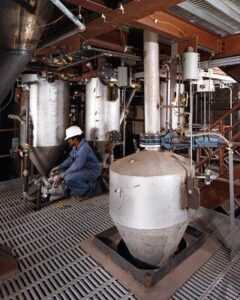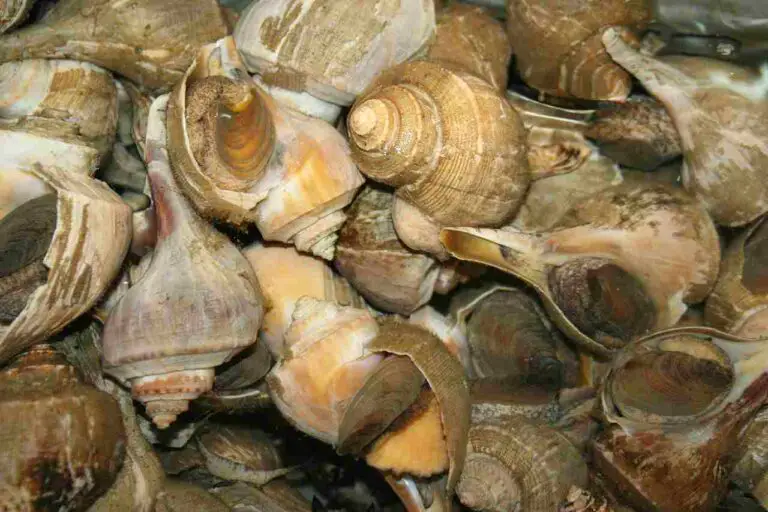3 Types of Gasification and their Characteristics Explained
Types of gasification are; moving bed, entrained flow, and fluidized bed gasification.
This article discusses the types of gasification and their characteristics, as follows;
1). Moving Bed Gasification (as one of the Types of Gasification)
Moving bed (alternatively referred to as ‘fixed-bed’) gasification is a type of gasification that utilizes direct heat transfer to treat organic feedstock in a cyclic manner that conserves energy and raw materials.
In moving bed gasification, the feedstock is allowed to navigate downward through the gasifier under the influence of gravity [5].
This downward navigation is aided by a bed that usually comprises of inert granular materials like alumina or sand, hence the name; ‘moving-bed’. It is referred to as fixed bed in some studies, based on the fact that the inert bed is confined to the vertical internal region of the gasifier.
The function of this bed is to provide a supportive and conductive base that allows the feedstock to interact effectively with heat, without any unwanted thermo-chemical reactions.
Heat energy is itself provided by feeding a high-temperature material called a ‘gasification agent’ into the gasifier or reactor.
The gasification agent is introduced such that it navigates in a direction opposite that of the feedstock. Usually, this is the upward direction; which allows the feedstock to collide with the heated materials as it moves through the gasifier, thereby facilitating efficient thermal conversion.
The choice of gasification agent generally depends on the nature of feedstock (size, composition), and the desired end-products of the gasification process. Examples of gasification agents include product gases, oxygen, and steam [2].
In moving-bed gasification, thermal cracking (which may be described as pyrolysis, thermal decomposition, or gasification) occurs when the feedstock is subjected to the high-temperature of the inert bed, which is derived from the gasification agent(s) by conduction.
Because the bed is in direct contact with the feedstock material, heat transfer from the gasification agent becomes more efficient. The feedstock also comes in direct contact with the gasification agent as it moves downward on the inert bed.
Moving bed gasification beneficial because of its cyclic nature. The basic mechanism behind moving bed gasification, facilitates recycling of materials.
For example, hot products gases (collectively called ‘syngas’) which are derived as the feedstock is converted in the gasifier, can be used as a gasifier for further conversion of feedstock. Similarly, coolants can be recycled and reused through circulation and heat exchange.
This arrangement maximizes energy conservation and energy efficiency, while ensuing the formation of quality end-products.
Moving bed method is relatively versatile, and can be implemented for various types of feedstock, desired products, and physicochemical conditions.
2). Entrained Flow Gasification
Entrained flow gasification is one of the most common types of gasification in practical scenarios.
In entrained flow gasification, the feedstock and gasification agent are introduced into the gasifier such that they navigate in the same direction through the system. Often, both components (feedstock and gasification agent) are introduced simultaneously.
The goal of this type of gasification is to achieve thermal conversion through effective and instantaneous heat circulation. It differs from moving bed gasification which achieves thermal conversion through collision of feedstock and gasification agents.
To ensure that heat is evenly distributed across the molecules of the feedstock, pulverization or shredding is applied [6]. This reduces the particular size of the feedstock to about 100 microns or less.
Also, entrained flow gasification proceeds at extremely-high temperature of up to 1,000°C and above [4], to facilitate conversion and yield.
Entrained flow gasification is often applied for the treatment of organic slurry.
3). Fluidized Bed Gasification (as one of the Types of Gasification)
Fluidized bed gasification involves the introduction of pressurized, hot gas into the gasifier, such that the particles of the feedstock and the inert bed may become suspended in the fluid [3].
The hot gas (gasification agent) is often rich in oxygen and steam, and is introduced into the gasifier in a direction opposite to that of gravity. This is similar to the approach used in moving bed gasification, although in this case, the feedstock does not necessarily navigate in a downward direction, or at all.
The suspension of feedstock particles ensures that efficient mixing and heat distribution occur, both of which are necessary for high yield.
In order for the fluidized bed method to be effective, feedstock must be in particulate form. However, the size of particles should not be extremely small, as this could cause scattering and poor circulation of heat.
Like entrained flow method, fluidized bed gasification requires very high temperature of 850°C and above to be effective [1].
Due to the gaseous mobility of the process, carbon capture equipment can be integrated into fluidized bed gasification systems for effective CO2 recovery. Also, the presence of large volumes of oxygen implies that reduction is necessary during the post treatment stage.

Conclusion
Types of gasification are;
1. Moving-bed Gasification
2. Entrained-flow Gasification
3. Fluidized-bed Gasification
References
1). Arena, U.; Zaccariello, L.; Mastellone, M. L. (2010). “Fluidized bed gasification of waste-derived fuels.” Waste Management 30(7):1212-9. Available at: https://doi.org/10.1016/j.wasman.2010.01.038. (Accessed 8 October 2022).
2). Islam, W. (2020). “Effect of different gasifying agents (steam, H2O2, oxygen, CO2, and air) on gasification parameters.” International Journal of Hydrogen Energy 45(56). Available at: https://doi.org/10.1016/j.ijhydene.2020.09.002. (Accessed 8 October 2022).
3). Mazumder, A. M. (2010). “Development of a Simulation Model for Fluidized Bed Mild Gasifier.” Available at: https://www.researchgate.net/publication/254723117_Development_of_a_Simulation_Model_for_Fluidized_Bed_Mild_Gasifier. (Accessed 8 October 2022).
4). Qin, K.; Lin, W.; Jensen, P. A.; Jensen, A. D. (2011). “High-temperature entrained flow gasification of biomass.” Fuel 93(1). Available at: https://doi.org/10.1016/j.fuel.2011.10.063. (Accessed 8 October 2022).
5). Schwabauer, A.; Mancini, M.; Poyraz, Y.; Weber, R. (2021). “On the Mathematical Modelling of a Moving-Bed Counter-Current Gasifier Fuelled with Wood-Pellets.” Energies 14(18):5840. Available at: https://doi.org/10.3390/en14185840. (Accessed 8 October 2022).
6). Svoboda, K.; Pohořelý, M.; Harrman, M.; Martinec, J. (2009). “Pretreatment and feeding of biomass for pulverized entrained flow gasification.” Fuel Processing Technology 90(5):629-635. Available at: https://doi.org/10.1016/j.fuproc.2008.12.005. (Accessed 8 October 2022).



